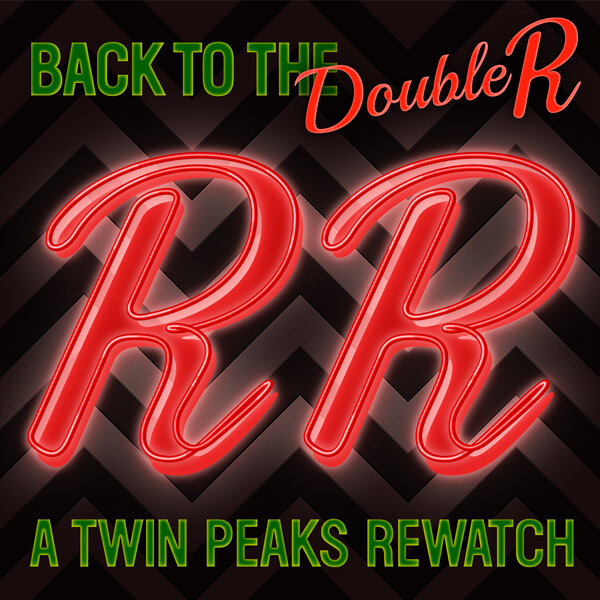Agent Cooper and the Importance of “Zen”
art by Jonathan Pérez
Twin Peaks is a show that takes its time. In the pilot episode, one may wonder if Kyle MacLachlan’s is the lead character of the show, given that he enters the show nearly halfway into the story. And even then, Cooper is in many ways more of an exposition machine instead of fleshed-out character—the constant recordings made to “Diane” over his omnipresent tape recorder is a clever way for the show to catch viewers up on what is going on. The early episodes also make use of Cooper’s ability to read body language and logic to suss out the secrets the town holds close to the vest. That ability provides many of the humorous moments in the early episodes. Michael Ontkean looks perpetually bemused by this outsider; as Sheriff Truman he gives off a look that says “I can’t believe he just said that” that is parts awe, bemusement, and shock. It makes for a very entertaining way to introduce the protagonist into the story. Through the first two chapters in the Twin Peaks saga, Cooper (and Kyle MacLachlan) is having all kinds of fun munching down donuts, sipping the hottest and blackest Cup O’ Joe and admiring the trees, yet he is more plot device than fleshed-out character.
That changes in the third episode, “Zen, Or the Skill to Catch a Killer”. David Lynch and Mark Frost reveal the foundations of the character and set Agent Cooper upon his journey. Three scenes in the episode speak to this development. The first scene in that does this is (what we at Back to the Double R have affectionately called) the “Rocks and Bottles” sequence. Cooper gathers Sheriff Truman, Deputies Andy and Hawk, and administrative assistant Lucy to demonstrate a Tibetan deductive technique “involving mind-body coordination operating hand in hand with the deepest level of intuition.” Cooper will throw a rock at a bottle balanced on a tree stump exactly 60 feet and 6 inches away from him—the exact measure of the distance between the slab on a pitcher’s mound and home plate on a standard Major League Baseball diamond, a detail that Lynch and Frost never expound upon, leaving the viewer to speculate as to its specificity. (Was Cooper a pitcher? That is certainly an activity that combines deep levels of mind-body coordination. Are either Lynch or Frost big time baseball afficionados? It is never explained, only left open to interpretation, which of course is a fantastic way to engage an audience, and something Twin Peaks does so wonderfully over and again.) This action is combined with a list of names beginning with the letter “J”, and if a rock hits a bottle, that is a name worth investigating.
As discussed in the companion podcast for “Zen, Or the Skill to Catch a Killer”, this scene not only does an efficient and entertaining job of recapping the mystery and its suspects for the viewing audience (almost well enough that it renders the pilot and subsequent episode moot), but it clues the same audience into what makes Cooper tick. I am always struck by the fastidiousness and precision of the instructions Cooper gives to his friends from the Twin Peaks Sheriff’s Department. Hawk holding the bucket of rocks, Sheriff Truman reading out the names of the suspects and their relationship to Laura Palmer, the very explicit instructions about crossing off the names Cooper gives to Lucy (it is great that Lucy gets equally persnickety when the rock hits the bottle but does not break, she’s already on Cooper’s wavelength) all reveal a method to Cooper’s seeming madness; there is a clear set of rules for everyone to follow.
It is also noteworthy that Cooper tells the crew about his fascination with Tibet, and his deep love and sympathy for the Tibetan people and their spirituality. Everyone has a relationship to religion, be it a true believer, an atheist or somewhere in between. When you meet a new person in real life that is more than a passing acquaintance, finding out their relationship to spirituality is one way to deepen the relationship (or perhaps you find a way to avoid it respectfully, which is also a sign of a deepening friendship). Even if you know nothing about Tibet or Buddhism or Eastern religions (and again, Lynch and Frost don’t waste time explaining this), you know it is important to Cooper. For a character who has already shown a propensity for exact details, it is easy to see why a religion based in balance would appeal to Cooper and how it will guide his decision making going forward.
I also like how this scene demonstrates the absolute trust each of the people in the Twin Peaks Sheriff’s Department have already placed in Cooper. He has already ferreted out many of the town secrets, he was able to find details others did not even think to look for (like the letter “R” hidden under Laura’s ring finger), and his stated conviction to be a partner with Sheriff Truman and his team instead of opposing them. Hawk displays skepticism but Truman tells his deputy to go along with Cooper’s methods. Andy uses humor to brush off getting hit with a rock on an errant throw from Coper. Lucy positively jumps for joy when the agent finally breaks a bottle. This scene knits together Cooper with the rest of the unit; and our heroes will act united in solving the mystery of who killed Laura Palmer. If Sheriff Truman and co can trust Agent Cooper, we in the audience can trust Agent Cooper.
That trust pays off in the next scene, which is another thing Lynch and Frost and the writers of Twin Peaks do very well: establish a foundational detail or a clue and then not waste time delivering a payoff. “Zen, Or the Skill to Catch a Killer” introduces another FBI Agent to the small town of Twin Peaks: Albert Rosenfield (portrayed by the late, great, and absolutely gone way too soon Miguel Ferrer), who unlike Cooper opts for abrasion instead of inclusion when it comes to Sheriff Truman and company. Albert is clearly set up as a foil to Cooper, but the writing also points out that where the forensic analyst fails in interpersonal relationships, he is absolutely an expert in his field. While Albert’s brilliance manifests itself differently than Cooper’s, they both are touched by genius.
Albert and Sheriff Truman inevitably come to blows (and Truman utters an unfortunate slur that would never appear on television today), and the most interesting detail in that scene are not the two men quarrelling, but the reaction Cooper gives. Cooper is clearly smiling and amused. MacLachlan gives Cooper the look of a child who as set a trap for a mouse and is bristling with anticipation for the trap to be sprung. It is a look that suggests Cooper has perhaps foreseen this interaction and he is either pleased to be right or delighted in being surprised. Or maybe there is simply the desire to see what happens when opposing forces collide. Impishness and curiosity and a sense of the perverse reside in those eyes. Either way, it suggests that Cooper is not merely a strait-laced Clark Kent-type but perhaps someone comfortable dipping his toes into chaos.
The examination of Cooper’s spirituality and his peek-a-boo of mischief sets up the grand finale of “Zen, Or the Skill to Catch a Killer”, the extended dream sequence set in the Red Room. Also known as: The Most Famous Scene In Twin Peaks. If you are familiar with the international version of the Twin Peaks pilot, you know that this material was lifted from that ending and repurposed into the finale of this episode. (In fact, this Red Room sequence is considered the canonical one, not the one in the international pilot.) This is a trip inside the subconscious of our protagonist. I am not enough of a television historian to know if this was the first use of an extended and truly bizarre dream sequence, but I do know that wherever the bar was for dream sequences in television, Lynch and Frost raised it high and set the gold standard.
A feast for the senses and catnip for lovers of mystery, the Red Room sequence is a moment in television that can be described (don’t forget the scenes in the dream leading up to the Red Room—the MIKE and Killer BOB sequences, Al Strobel reciting “Fire Walk With Me”, the creepy scenes at the Palmer home) but isn’t fully understood until experienced. The fact that the most (relatively) normal thing we see in the dream is an aged Cooper (perhaps 25 or so years older?). Among the backmasked dialogue, the shimmy-shake of The Man From Another Place (“Let’s Rock!”), Cooper’s tie, the chevron tiling, and perhaps the biggest shock of all—Laura Palmer herself (or is it Laura Palmer’s cousin who looks just like her?), who whispers a secret to Cooper, one barely notices the old man taking it all in, the curiosity and appetite still there (perhaps more on Cooper’s appetites later on down the road). What it all means has yet to be uncovered but it also tantalizes audiences still with the narrative are tantalized into taking this ride alongside Special Agent Dale Cooper. Even he cannot shake the dream, snapping his fingers to “Dance of the Dream Man” as he awakens, the episode ending on Michael J. Anderson’s boogie.
This is arguably the greatest episode of the series, and what a gift for it to come so early in the run of the show. Twin Peaks is not always a show for every audience and one underrated aspect of the episode is that if this is all too surreal for you, you can gracefully exit the series but still come away with a decent understanding of what the show is about and the itches Lynch and Frost are trying to scratch. For the audiences who stay—and we here at Back to the Double R do want you to stay—this is the type of episode that will garner tremendous goodwill for audiences.
“Zen, Or the Skill to Catch a Killer” is the episode that lodged Twin Peaks in the firmament. Look no further than the multitudes of parodies of Twin Peaks over the past three decades; nearly all of them reference Cooper’s dream of the Red Room. This episode also gave television permission to be surreal; no way does a show like The Sopranos—about as far away from Twin Peaks as you can get—find room for the psychoses, subconscious, and wacky dreams of a suburban mafia capo. No way does a show like LOST even exist. Yet all the strobe effects, backwards talking, the little person in a red velvet leisure suit, “Fire Walk With Me” mean nothing without Cooper there to experience it. Cooper is the avatar for the audience here, and we experience the dream through him. Like Agent Cooper, I’ve never quite been able to shake it. We are there with him, at the onset of his journey to self-discovery. And oh—dear listeners, what a journey it will be and what places it will take us.


